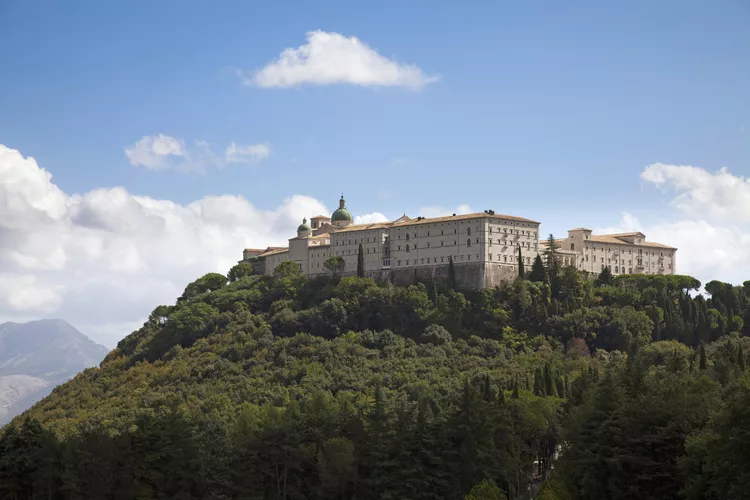1. Overview of Montecassino Abbey
2. History of Montecassino Abbey
3. Highlights of a Visit
4. Montecassino Abbey Museum
5. Location of Montecassino Abbey
6. Visitor Information
If you’re traveling between Rome and Naples, the beautiful Abbey of Montecassino is well worth a visit. The Abbazia di Montecassino, perched on the mountaintop above the town of Cassino, is a working monastery and pilgrimage site but is open to visitors. Montecassino Abbey is famous as the scene of a huge, decisive battle near the end of World War II, during which the abbey was almost completely destroyed. It was rebuilt after the war and is now a major destination for tourists, pilgrims, and history enthusiasts.
Monte Cassino Abbey History
The abbey on Monte Cassino was originally founded by Saint Benedict in 529, making it one of Europe’s oldest monasteries. As was common in the early days of Christianity, the abbey was built over a pagan site, specifically on the ruins of a Roman temple to Apollo. Consequently, the monastery became known as a center of culture, art, and learning.
Montecassino Abbey was destroyed by the Longobards around 577, rebuilt, and again destroyed in 833 by the Saracens. By the tenth century, the monastery resumed its function, filled with beautiful manuscripts, mosaics, and works of enamel and gold. After being affected by an earthquake in 1349, it underwent extensive reconstruction with many additions.
During World War II, Allied armies invaded from the south, attempting to displace German forces from Italy. Due to its high vantage point, Monte Cassino was mistakenly believed to be a strategic hideout for German troops. In February 1944, the monastery was bombarded by Allied planes and completely destroyed. It was only later that the Allies realized the abbey had served as a refuge for civilians, many of whom sadly lost their lives during the bombings. The Battle of Monte Cassino marked a pivotal turn in the war but at an immense cost—over 55,000 Allied troops and more than 20,000 German troops perished.
Despite the destruction, most of Montecassino Abbey’s artifacts, including priceless illuminated manuscripts, had been moved to the Vatican in Rome for safekeeping during the war. The abbey was meticulously reconstructed following its original design and treasures were restored. It was reopened by Pope VI in 1964. Today, it is difficult to tell that it has been destroyed and rebuilt several times.
Highlights of a Visit to Montecassino Abbey
The entrance cloister was the site of the temple of Apollo, transformed into an oratory by Saint Benedict. Next, guests enter the Bramante cloister, constructed in 1595. In its center is an octagonal well, and from the balcony, visitors can enjoy magnificent views of the surrounding valley. At the foot of the staircase stands a statue of Saint Benedict from 1736.
As visitors approach the basilica, they encounter three bronze doors, with the middle door dating back to the 11th century. Inside the basilica, remarkable frescoes and mosaics await. The Chapel of Relics contains reliquaries dedicated to several saints. Additionally, the crypt, dating from 1544 and carved directly into the mountain, is adorned with stunning mosaics.
Montecassino Abbey Museum
Before entering the museum, visitors can admire medieval capitals and remnants of columns from Roman villas, as well as a medieval cloister featuring the remains of a 2nd-century Roman well.
Inside the museum, artifacts include mosaics, marble, gold, and coins from the early medieval period. Noteworthy exhibits feature 17th to 18th-century fresco sketches, prints, and drawings related to the monastery. Literary displays showcase book bindings, codices, books, and manuscripts from the monks’ library, spanning from the 6th century to contemporary times. A collection of religious items from the monastery and Roman findings, along with photographs of the WWII destruction, can also be found near the end of the museum.
Montecassino Abbey Location
Montecassino Abbey is situated approximately 130 kilometers south of Rome and 100 kilometers north of Naples, on the mountain overlooking the town of Cassino in the southern Lazio region. Visitors can access the site via the A1 autostrada by taking the Cassino exit, followed by an 8-kilometer journey up a winding road. Trains service the town of Cassino, and from there, guests must take a taxi or rent a car.
Montecassino Abbey Visitor Information
Visiting Hours: Daily from 8:45 AM to 7 PM from March 21 to October 31. From November 1 to March 20, hours are reduced to 9 AM to 4:45 PM. On Sundays and holidays, hours are 8:45 AM to 5:15 PM.
On Sundays, mass is held at 9 AM, 10:30 AM, and 12 PM, during which time access to the church is restricted to worshippers only. Currently, there is no admission fee.
Museum Hours: The Montecassino Abbey Museum is accessible daily from 8:45 AM to 7 PM from March 21 to October 31. From November 1 to March 20, it is open on Sundays only, from 9 AM to 5 PM. Special daily openings are available from the day after Christmas until January 7, the day preceding Epiphany. Admission to the museum costs €5 for adults, with discounts available for families and groups.
Official Site: For additional information and updates regarding visiting hours, please refer to the official Abbazia di Montecassino website.
Regulations: Smoking and eating are prohibited. Flash photography, tripods, shorts, hats, mini-skirts, or sleeveless tops are also not permitted. Visitors are expected to maintain a quiet atmosphere and respect the sacred environment.
Parking: A large parking area is available, with a minimal fee for parking.
This article has been updated by iBestTravel.




